Contemporary Christian Music
 |
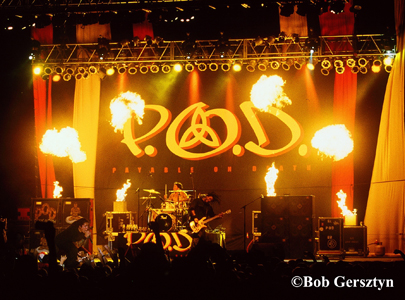 |
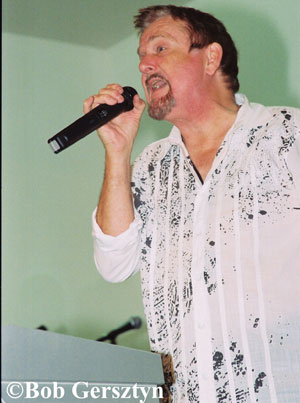
|
A Brief History
Article and photos by Bob Gersztyn
(June 2021)
In 2012, ABC-CLIO academic book publishers published my book Jesus Rocks The World: The Definitive History of Contemporary Christian Music, volumes 1&2- It was based on my forty years of involvement with the genre that originally began as "Jesus Music" at the very end of the 1960's and the beginning of the 1970's.
After I was discharged from the army in 1968, I became a hippie college student back home in Warren, Michigan that attended concerts and tripped on LSD and mescaline over a hundred times, searching for God. After three years I flushed my acid down the toilet and began reading the Bible while smoking pot and listening to Jesus Christ Superstar.
A few months later, I moved to Los Angeles where I finished college and found a religious revival within the counter culture, made up of "Jesus freaks" and they had their own music that I never heard before. What TIME magazine called the "Jesus movement" was comprised of two parts: first were the traditional church youth that discarded old traditions in favor of new and fresh ones and the other half was comprised of counter culture hippies, seeking a solid spiritual foundation to build their lives on. I changed my major from photography to theology and graduated as an ordained Foursquare minister that was appointed to an associate pastor position at an inner city church in the Highland Park district of L.A. One of my duties was to schedule, promote and host "Jesus Rock" concerts on Friday nights.
The 1960's began with a movement away from religion as college students scrawled Nietzsche's "God is Dead" quote on bathroom walls, followed by the 1966 TIME magazine cover asking the question "Is God Dead?" By the end of the decade, that question was answered with a definite "No!" Pop music radio had a string of hits talking about Jesus, from "Ocean's" "Put Your Hand in the Hand" to Norman Greenbaum's "Spirit in the Sky." The God of evangelical fundamentalist Pentecostal Christianity was very much alive in the hearts and minds of millions of "Jesus freak" converts. The 1960's decade began with the promise of "Satori" (instant enlightenment) through the use of entheogenic agents like LSD, mescaline, peyote, psilocybin and even marijuana. The same psychedelic drugs had been and were still being used by primitive aboriginal people's as an important part of their religious ceremonies and it was now instrumental in helping to instigate a religious revival among the now coming of age baby boomers.
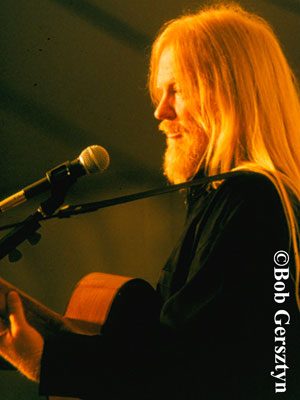
Larry Norman, 2000
Artists like Larry Norman, Mylon Lefevre, Phil Keagy, The Talbot Brothers and Fred Caban were the first to release religious record albums that were in the folk rock and hard rock genres rather than the traditional gospel and southern gospel style. Larry Norman who many consider the father of "Jesus Rock" was originally in a bay area group called People that had a regional hit with a cover of the Zombies song "I Love You." After failing to convince the record company to title their album We Need a Whole Lot More of Jesus and a Lot Less Rock'n'Roll, Norman quit the band in 1968. He spent a year playing at Hollywood First Presbyterian church's Salt Company coffee house and wherever else he could in Los Angeles and in 1969 he recorded and released Upon This Rock on Capitol Records which is considered by many to be the very first "Christian rock record."
Mylon LeFevre was a member of a famous Southern Gospel singing family (The LeFevres) that backslid after he was discharged from the army and began smoking pot. He formed a pioneering Southern Gospel rock band (Mylon) that I saw perform twice in Detroit, Michigan at the Eastown theater. He was part of the regular rock scene and produced secularly-accepted albums and interacted and shared the stage with all the rock stars of that era. Likewise, stellar guitarist Phil Keagy was part of Glass Harp, another act that played at the Eastown who by the early 1970's went solo strictly as a "Jesus rock" artist.

Mason Proffit, 1971
The Talbot Brothers were a country rock band that inspired the Eagles. The brothers' band was originally called Mason Proffit and used a backwoods mountain man motif for their act. The music was socially conscious and when the brothers Terry and John Michael left the group to follow Jesus, they recorded a "Jesus rock" album called Reborn. By the end of the 1970's John Michael Talbot became a Franciscan monk and released worship albums. I saw Mason Proffit perform in 1971 at both at the Eastown in Detroit and at the "Golden Bear" in Huntington Beach after moving to L.A. After graduating from high school, Fred Caban formed Agape, the first psychedelic gospel hard rock group and began recording albums. I purchased their second album in 1971 and it blew me away- it felt like Jimi Hendrix singing about Jesus.
The epicenter of the counter culture "Jesus freak" revival in Southern California was at Calvary Chapel, Costa Mesa, whose pastor was Chuck Smith. Smith was a Foursquare minister who was the pastor of an independent church that had a congregation of a couple hundred when he began doing weekly inductive Bible studies, beginning with the book of Genesis. His teenage children convinced him to allow barefoot longhaired hippies to attend services. At the very same time, a charismatic young man named Lonnie Frisbee started attending services. Frisbee saw Jesus on an LSD trip and was called into the ministry as an evangelist so he combed the beaches and converted thousands of hippies that he brought to Calvary Chapel, where he was now an assistant pastor. By the end of the 1970's Calvary Chapel, Costa Mesa became the largest protestant church in the US, with a weekly attendance of twenty-five thousand and was the very first mega-church.
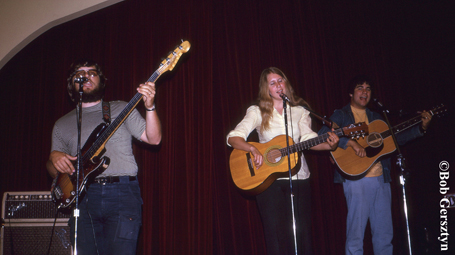
Children of the Day, 1973
Out of the thousands of young baby boomer teenagers and young adults that attended Pastor Smith's church, some were musicians. People like Chuck Girard had a couple of doo wop hits back in the early pre-Beatles 1960's. Then, he worked with the Beach Boys and sang lead on a radio hit called "Little Honda." Living on his royalties, he moved to Hawaii and after 500 acid trips, he returned to the mainland to find Jesus and form the group Love Song at Calvary Chapel. The band became the Christian answer to the Beatles. Another Calvary band was Children of the Day, four high school friends comprised of sisters Marsha and Wendy Carter and two male friends that were all involved in music. They formed a "Jesus music" quartet that sang beautiful harmonies and were the easiest for the older church members to accept and enjoy. Yet another Calvary band was Mustard Seed Faith, led by Oden Fong whose parents were Hollywood actors. After high school, he joined Timothy Leary's commune and when he took a super dose of one hundred hits of acid at one time, he saw Jesus and became a born again Christian. Mustard Seed Faith was an acoustic three man group that had a happy Beach Boys sound.
Even though Calvary Chapel was producing a cadre of Christian music artists that appealed to the newly converted "Jesus freaks" that demanded record albums to replace their need for secular non-Christian music, it didn't fit the commercial model. Maranatha Records began as a solution to insuring that the music artists were able to support themselves ("Maranatha" is an Aramaic word and means "Come Lord," inviting the Second Coming or the end of the world). Invitations to play regionally were always accepted and if three or four artists drove a hundred miles to get there, sometimes the offering would barely cover gas money for the small churches. However, if they sold albums, then the profits from them after production costs would go to the artist.
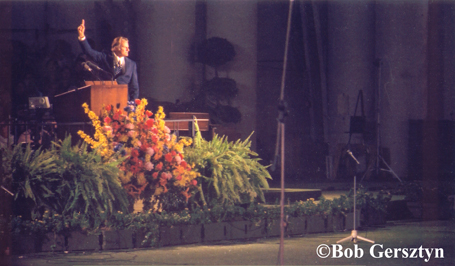
Billy Graham at the Hollywood Bowl, 1974
The existing conservative church did not accept the new "Jesus music" and in some cases, Christian bookstores and outlets refused to carry the genre. It wasn't until 1972, at Explo 72, a weeklong festival in Dallas that Christian rock was finally accepted there by legendary evangelist Billy Graham. Prior to that, he called it 'the devil's music,' but on Saturday June 17, there was an all day long Christian music festival that was open to the public and Graham was the speaker. The media called Explo 72 the "Christian Woodstock" and it drew close to 200,000 people. Larry Norman, Maranatha artist Love Song and other Christian rock performers played throughout the day.
The very first album that Maranatha Records released in 1971 was titled The Everlastin' Living Jesus Music Concert and is commonly referred to as "Maranatha One." It was a compilation album with each artist performing one song. There were a series of Maranatha albums released throughout the 1970's. Once an artist was featured on one of the compilation albums, if they had the material, they would record their own album, just as Children of the Day, Mustard Seed Faith and Debbie Kerner did. Kerner was the first solo female "Jesus music" artist that recorded an entire album on the Maranatha label.
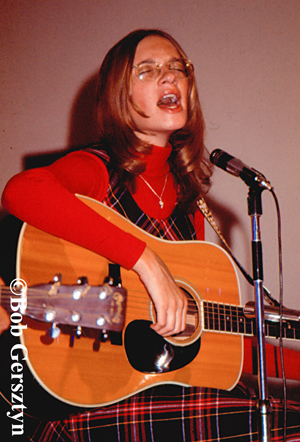
Debbie Kerner Retino, 1976
One of the biggest Christian record labels was WORD Records, located in Waco, Texas. WORD was started by Jarrel McCracken in the early 1950's as a teaching tool for Youth ministries. It primarily produced traditional gospel and recorded sermons. To record the new untraditional "Jesus music," new subsidiary record labels like Light and Myrrh were created and headed up by Ralph Carmichael and Billy Ray Hearn. The first artist recorded by Carmichael on Light Records was Andrae` Crouch's Take the Message Everywhere in 1968. It included "The Blood Will Never Lose its Power," a song that he wrote when he was ten years. He pioneered singing traditional gospel in an R&B style and became one of the most famous black gospel artist of the 20the century.
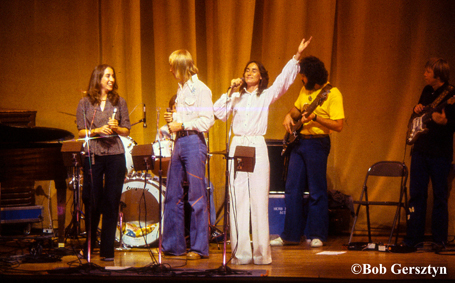
2nd Chapter of Acts, 1978
Billy Ray Hearn began Myrrh Records in 1972 and former folk rocker Barry McGuire was his first artist. McGuire was famous for the1965 anti-war radio hit "Eve of Destruction." A downward spiral from drugs, depression and disillusionment drove McGuire to Jesus and Hearn recorded his first "Jesus Rock" album, Seeds. McGuire's album used a trio of backup singers that soon recorded their own album under the name, The 2nd Chapter of Acts because they were Pentecostal and that chapter in Acts is about the "Baptism in the Holy Spirit." They, like Children of the Day, sang beautiful harmonies that were loved by both the established church and the New Paradigm ones. In 1976, Billy Ray Hearn founded Sparrow Records and brought his Myrrh recording artists with him. The other major Christian record label was Benson Records that had existed since 1902 as a sheet music company. In the late 1960's, it primarily produced Southern gospel music from artists like the Bill Gaither Trio, so in the 1970's, it began Greentree and Star Song to handle the new non-traditional artists.
The impact of the religious revival that TIME magazine labeled the "Jesus movement" effected Western civilization as far as Western Europe. The annual Greenbelt Festival began in England in 1974 and featured the best Christian performers from America, Europe and around the world. The most famous of the British Christian rock artists was Cliff Richard, who achieved fame with his group the Shadows back in the 1950's before the Beatles. One of the most popular British Christian acts in America was Malcolm and Alwyn, a duo with a couple of popular albums titled Fools Gold and Wildwall- their style was a cross between Simon and Garfunkel and T. Rex.
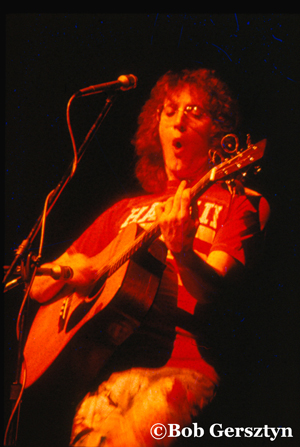
Randy Stonehill at Occidental College, 1979
When Larry Norman played in England, he met Malcolm and Alwyn and convinced them to come to America. Norman had his own record label that he started called Solid Rock Records where he produced his own albums as well as other artists like Randy Stonehill, the J C Power Outlet, Mark Heard and Tom Howard. In the mid 1970's Norman did a deal with WORD Records so they would take care of Record distribution.
Even though Southern California was the epicenter of the Jesus movement and most of the new Christian record labels were located there, it wasn't the only location that produced "Jesus music." The Mid West had the Adam's Apple coffee house in Ft. Wayne, Indiana that produced artists like Honeytree and Petra. Ohio Guitarist Glenn Schwartz started the James Gang before he handed it over to Joe Walsh and became the lead guitarist for Pacific Gas and Electric (who had their own hit with "Are You Ready"). However, after too much contemplation on acid, Schwartz abandoned his successful career. He joined a small "Jesus freak" religious cult that had their own Christian band called The All Saved Freak Band, which was fronted by its psychopath lead singing pastor.
And then there was a name that even most secular audiences know. Amy Grant began her career as a teenager in Nashville, Tennessee in the mid 1970's, she became the biggest Christian crossover artist since Sam Cooke. Normally, Christian Contemporary Music (CCM) albums are only available in Christian Bookstores and outlets but Grant's albums were distributed by a joint deal between A&M Records and Myrrh Records. The result was that she won six Grammy Awards and twenty-two Dove Awards.
The Dove Award is the Christian version of the Grammy Award for CCM artists. It is controlled by the Gospel Music Association (GMA), which is located in Nashville, Tennessee. In the late 1970's "Jesus music" became "Contemporary Christian Music" and headquarters was moved from Southern California to Nashville, the Country Music capitol, where GMA's headquarters was located. The reason why CCM is called "Contemporary Christian music" is because in the beginning, when Calvary Chapel, Costa Mesa was exploding at the seams, they erected a gigantic Circus tent while a new sanctuary was being built, and they also began regular Saturday night concerts. The concerts were broadcast and hosted by a radio DJ named John Styll who was also the music editor of Contemporary Christian Acts magazine. It was the Christian equivalent to Rolling Stone and was part of Maranatha Records. They were the first to seriously tabulate Christian record sales and the magazine was well established by the time that WORD Records acquired it and it became part of the GMA. The name of the publication was changed to Contemporary Christian Music which now became the name of the genre. The GMA began the Dove Award in 1969 for Southern Gospel artists. However, Christian rock was not recognized with an award until 1988 when Mylon LeFevre and Broken Heart won the Christian rock album of the year with Crack the Sky.
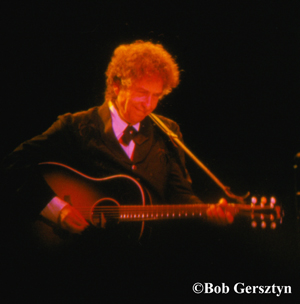
Bob Dylan, 1998
At the same time that CCM was entering the mainstream, an amazing conversion took place with one of the most highly regarded music artists of the era. Bob Dylan underwent his conversion as a "born again" Christian at the Vineyard church in Malibu. It was a spin off from Calvary Chapel, Costa Mesa and was founded by Maranatha Records musician Ken Guliksen as an outreach to rock and movie stars. After former Righteous Brothers keyboardist and manager John Wimber became the pastor of the Vineyard, he employed Lonnie Frisbee to expand the congregation. Dylan released three Christian albums during what is now termed his 'Christian phase.' The second album was titled Saved and contained some hardcore gospel songs. By the 21st century, Calvary Chapel and the Vineyard had three-thousand churches worldwide, comprised of millions of converts.
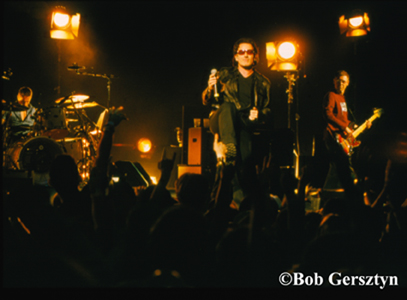
U2, 2001
The members of U2 were high school students during the late 1970's in Dublin when they were impacted by the "Jesus movement." They wrote and performed religious imagery that was released on Island Records and their first two albums were primarily available in Christian bookstores thought they would also of course go on to becoming one of the best-selling rock acts ever. The Call was a cutting edge alternative rock group that included Garth Hudson from The Band for a period and was led by Michael Been. They, like U2, dealt with the spiritual ramifications of the reality that we live in.
Along with Christian record labels, churches are the normal venue to see Christian rock performers, along with dozens of annual festivals across the country and around the world. The Cornerstone festival in Bushnell, Illinois takes place over the 4th of July weekend for four or five days. It features some of the biggest Christian artists along with new, upcoming ones. The festival was begun in 1984 by Jesus People USA, an international Christian group that came out of the Jesus movement in Chicago in 1972. There are general Christian music festivals and even genre specific ones. The oldest Christian festival is the ICHTHUS festival in Wilmore, Kentucky that began in 1970 as an answer to Woodstock. There was even a traveling festival called Festival Con Dios modeled after Lollapalooza.
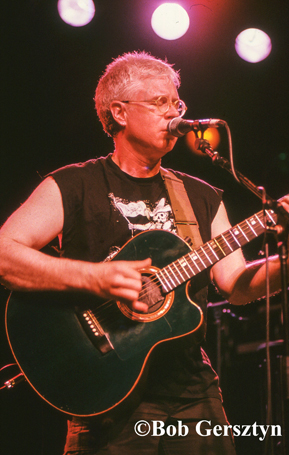
Bruce Cockburn, 1997
When a CCM artist becomes universally popular and has a more general appeal than most churches can accommodate (like Amy Grant, Michael W. Smith or Mercy Me), they then play regular secular venues. Then there are some Christian artists (and even some metal artists), like Jars of Clay, Lifehouse, Kings X and Stryper that were unique enough that they appeared on the pop music charts so they would play at secular venues too. There are also socially conscious Christian music artists that appear on regular record labels, like Bruce Cockburn, a Canadian artist that embraced liberation theology. Cockburn has released over forty albums exploring social and political issues from around the world as he reflects on the evolution of his own faith.
One genre of CCM that has always been the most popular among Christians over the past fifty years is "praise" or "worship" music. Until the 1970's, when the Jesus movement impacted existing churches and spawned new ones, most churches musical accompaniment was usually an organ and or piano. However, Baby Boomers introduced the regular use of an acoustic guitar that evolved into what is today called a "worship band." The worship band was made up of musicians in the church that accompany the worship leader who then leads the congregation in singing. In some cases, worship bands were high caliber enough of a performer that they would cut an album that got on the mainstream charts, like Lifehouse.
What is usually considered the very first "praise" or "worship" album was in 1974 when Maranatha Records released the Praise album. Prior to this, churches only sang traditional hymn's like "A Mighty Fortress is Our God" or "On Christ the Solid Rock I Stand." The new worship music was more contemporary sounding and consisted of repeated choruses, while at the same time it espoused traditional Christian theology. One of the first "praise" songs was "Father I Adore You," written by Terrye Coelho, a former topless dancer in 1972.
The late 1980's saw the establishment of Integrity Music as a CD club that exclusively offered worship music album compilations. In 1995, Integrity began a partnership with Hillsong Music in Australia. Hillsong congregations are the next generation of new paradigm churches that began with pioneers like Calvary Chapel and the Vineyard. Hillsong churches have effectively combined music with the Bible and good old fashioned showmanship in the spirit of Aimee Semple Mcpherson for the 21st century. Today, Christian music is still produced by Christian record labels but operate under the umbrella of major record companies. Billy Ray Hearn is the person responsible for founding and being the chairman of EMI's Capitol Christian music Group, one of the world's largest record labels, until his death in 2015. Some of the most popular CCM artists performing today are Kutless, Skillet, Switchfoot, Third Day and hundreds of others.

Associate Pastor Bob Gersztyn 1978
References:
Cusic, Don, editor & Gersztyn, Bob, contributing writer. (2010). Encyclopedia of Contemporary Christian Music: Pop, Rock, and Worship. Santa Barbara, California: Greenwood, an imprint of ABC-CLIO.
Cusic, Don. (2002) The Sound of Light: A History of Gospel and Christian Music. Milwaukee, Wisconsin: Published by Hal Leonard Corporation.
Di Sabatino, David, producer, director and writer, Gersztyn, Bob contributing photographer. (2009) Fallen Angel: The Outlaw Larry Norman (Film). Jester Media.
Di Sabatino, David, producer, director and writer. (2006) Frisbee: The Life and Death of a Hippie Preacher (Film). Jester Media.
Gersztyn, Bob. (2012). Jesus Rocks The World: The Definitive History of Contemporary Christian Music, volumes 1&2. Santa Barbara, California: Praeger, an imprint of ABC-CLIO.
McNeil, William, editor & Gersztyn, Bob, contributing writer. (2005). Encyclopedia of American Gospel Music. New York, NY: Taylor & Francis Group, LLC.
Powell, Mark Allan. (2002). Encyclopedia of Contemporary Christian Music. Peabody, Massachusetts: Hendrickson Publishers, Inc.
Sheehy, Sandy. (1990) Texas Big Rich (Biographical Chapter of Jarrell McCracken). New York, NY: William Morrow and Company, Inc.
Stevenson, Jeff C. (2015). Fortney Road: Life, Death, and Deception in a Christian Cult. Minneapolis-St. Paul, Minnesota: Free Thought House.